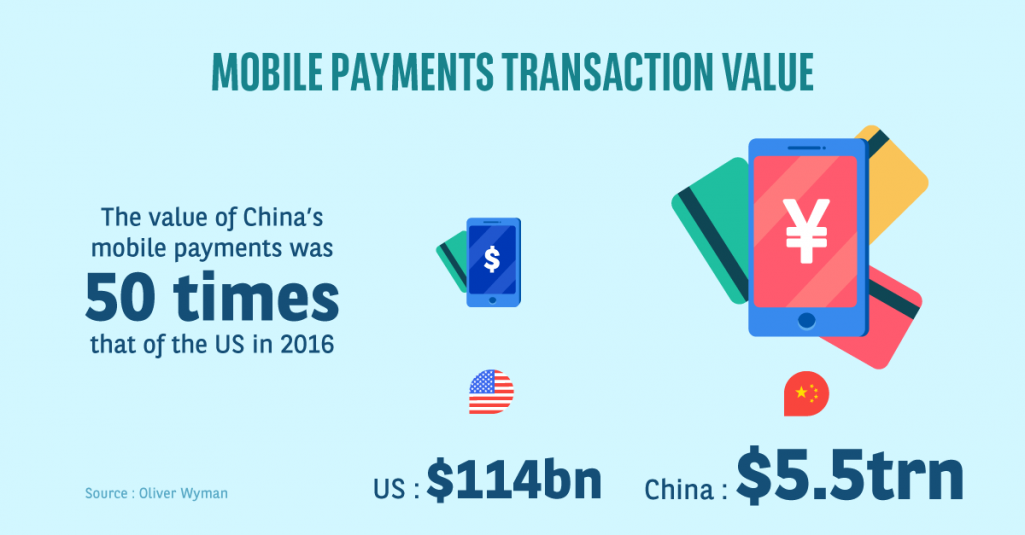In less
than half a decade, China’s financial technology (FinTech) sector
has seen phenomenal growth, surpassing the US as the number one
destination for venture capital investment, and transforming the
lives of many of its 1.3 billion-strong population.
Tumbling costs of handsets
from smartphone makers such as Xiaomi and Huawei are putting the
power of FinTech into the hands of China’s hundreds of millions of
farmers and rural workers, not to mention the burgeoning urban middle
class.
By extending digital banking, insurance and wealth management services to previously
Chinese citizens have embraced digital payments much more enthusiastically than their counterparts in the West
underserviced
communities, FinTech companies are helping to spread the fruits of
the nation’s decades-long economic boom beyond its coastal fringes
and big cities – a key policy objective of the central government and
core to meeting its goals of financial inclusion.
The spread of financial
services into previously untapped domestic markets shows the extent
to which Chinese companies such as Alibaba affiliate Ant Financial
and Tencent have aggressively filled the service gap in the world’s
most populous nation.
In doing so, China has
leapfrogged the developed world, aided by light-handed regulation,
ready access to capital and, crucially, a consumer base that is more
receptive to the digital transition than any other in the world.
Digital lure
More than eight in 10 Chinese say they now use at least one non-traditional online financial service provider; around double the uptake in developed economies such as the US and Japan.Peer-to-peer lending has also grown rapidly, with the outstanding loan balance for online platforms rocketing from 31 billion yuan (US$4.64 billion) in January 2014 to 856 billion yuan (US$130.66 billion) in January 2017, according to data published by consultancy firm Oliver Wyman.
Chinese citizens have embraced digital payments much more enthusiastically than their counterparts in the West, with many feeling as comfortable using their mobile phones to make high value purchases of items such as cars as they are buying coffee at a cafe, according to John Patrick Mullin, a Community Partner at Shanghai’s FinTech Connector, an online group to link entrepreneurs with thought-leader in the financial services space.
Serendipitous circumstance
It’s this combination of circumstances that has enabled the explosive growth of China FinTech sector, which according to Deloitte last year attracted US$7.7 billion in venture capital investment, 44% of the global total and significantly more than the US$6.2 billion that went to the US.The speed of China’s transition to digital financial platforms is in part down to simple good timing and its late-mover advantage.
FinTech providers have also been pushing against an open door thanks to the dominance of the nation’s big state-owned banks, which have traditionally seen their mission as one of servicing the needs of other state-owned companies. That has left a large portion of the country underbanked, especially individual consumers and small and medium-sized companies, Mullin says. He estimates that only about a fifth of all loans are to consumers.
SME currency challenge
Take Mofei Chen, the Shenzhen-based founder of Money Bazaar, a peer-to-peer foreign currency exchange platform. Chen studied at Cass Business School in London and worked briefly as a proprietary trader, where he experienced first-hand the favourable terms on which professional speculators could access currency markets. During his time in the UK, both as a student and trying his hand running an Amazon business importing goods from China, he also learned the hard way how expensive those same currency markets are for small businesses, entrepreneurs and ordinary citizens.“You have to be a really big international account for the banks to give you a good rate. When someone exchanges money for real reasons they are charged very high rates,” he says, “but speculative traders pay only one or two basis points – 100 basis points make up one percentage point – between the bid and ask.” His sense of the unfairness in the current system is one of the primary reasons he set up Money Bazaar.
The P2P system mimics a trading platform by matching bids between buyers and sellers of foreign currency. A Chinese student who wants to pay university fees overseas can match their need for the foreign currency with a buyer – say, a UK-based Amazon trader who wants to pay for Chinese goods in yuan – without having to pay the spread demanded by banks or traditional forex platforms. Money Bazaar takes a flat 0.15% fee. Most users “don’t want to make any profit, they just want to change money at the lowest cost,” he says.
Most Chinese FinTech firms are funded by domestic state-owned banks and private investors, and existing government restrictions on foreign investment continues to hamper overseas investors seeking exposure to the FinTech arena.
Excluded investors
Limits on foreign ownership of China’s traditional banks and mobile phone companies has also restricted access to FinTech alternatives too, with overseas investors excluded from the fundraising for Tencent’s WeBank, for example.
Meanwhile, China’s big FinTech players are building their user ecosystems abroad. Alibaba Group has stakes in Paytm, India’s largest mobile commerce company and Ascend Money in Thailand, while Ant Financial took a 60% stake in Taiwan’s Cathay Insurance and is also seeking US regulatory approval for its $1.2 billion acquisition of MoneyGram.
Tencent invested in Kik and Hike Messenger, Canadian and Indian apps seeking to become the WeChats of their respective markets.
Playing the waiting game
However, as cash-rich and ambitious Chinese FinTech firms look to expand overseas to limit their reliance on the domestic market and fuel further growth, opportunities exist for foreign investors to partner with Chinese firms and provide financing and local knowledge to facilitate expansion into international markets.It’s not just start-ups that are playing a patient waiting game: The same is true for global banks too, according to Loic Senechal, Head of Transaction Banking China at BNP Paribas.
“Corporate customers require a greater level of comfort in terms of a new system’s reliability, security and compliance than most consumers,” he says. “They also need certainty over the legal landscape governing FinTech.”
The good news is that China’s government has demonstrated its determination to build the regulatory framework businesses need to give them the confidence to make the jump into the rapidly changing world of digital finance, Senechal says.
In addition to the regulatory framework needed to support the sector, the government must manage a skills shortage that could limit expansion. According to the 2017 Hays Asia Salary Guide, some 70% of employers complained that they did not have enough trained staff to achieve their business objectives.

“Instead of absorbing talent from the traditional finance industry, we have preferred to recruit talent from within FinTech over the past 10 years,” he says.
Insurance innovation
It’s not only the banking and currency sector taking advantage of China’s FinTech innovation.Visitors to Beijing airport can see first-hand Baidu Inc.’s prowess at artificial intelligence as they’re scanned by the tech giant’s new facial recognition system there. It’s unlikely, though, that the company’s robots fielding questions from passengers will know the answer to the biggest bugbear of Chinese aviation: How to fix the world’s worst record of delayed flights.
Another technology company, though, can at least help compensate for hours waiting around the departure hall. Zhong An, China’s first all-online insurer, offers flight-delay insurance, calculated by using real-time weather reports, historical performance and other data. Ping An and PICC, two traditional insurers, are using telematics data analysis to improve how they price car insurance.
Consultancy Oliver Wyman predicts annual premiums from what it calls “ecosystem-oriented innovation” – such as flight-delay insurance – will reach 202 billion renminbi (US$31 billion) by 2020; policies based on wearable devices or telemetrics will generate 197 billion renminbi.
Threat or opportunity?
As recently as last year, traditional insurance companies had viewed FinTech as more of a threat than an opportunity, according to PwC’s Global Fintech Survey, with 74% seeing it as a disruptive challenge to their businesses. This year’s report found a majority – 52% – now put disruption at the heart of their business strategy, and that 45% have teamed up with InsurTech innovators, up from 28% in 2016.Surging rates of growth in China’s insurance industry have attracted the attention of big technology companies as well as FinTech start-ups and investors. That has been facilitated by government and regulators keen to see more of the population and businesses get protection.

“China’s regulators encourage innovation when there is a public policy benefit,” says Janos Barberis, founder of Hong Kong-based FinTech accelerator SuperCharger and one of Institutional Investor’s top-35 global FinTech leaders.
But regulators have recently tightened their oversight to curtail growing risks to the financial system: the China Insurance Regulatory Commission banned sales of short-term, high-yield life-insurance policies that it says are really high-risk investment products, and promised sanctions against those that flout rules.
The most to gain
Of the traditional financial services industries, insurance has perhaps the most to gain from the next wave of FinTech disruption. That’s because it’s likely to be driven by several mutually reinforcing technologies that include artificial intelligence and machine learning, the Internet of Things and big data – all of which are areas in which Chinese technology companies contend for global leadership.China is in the top three globally in terms of venture capital investment into AI and machine learning, big data and wearables, according to McKinsey & Company. Since 2014, Baidu, Alibaba and Tencent – collectively known as BAT – have also been pushing the boundaries of computing efficiency. Alibaba can process payments at three times the rate of the leading US payments system.
The emerging technologies also all have the potential to radically impact insurers’ costs, human resources, sales and product lines.
Assessing risk through data
Travel and shopping, leisure activities, driving habits, employment and other information gleaned from consumers’ data, for example, can help InsurTech companies make better assessments of risks attached to a policyholder – or that same person’s risk appetite for investment. Technology that can customize, market, distribute and automate the entire transaction process – and that can do so at scale – should lift sales and cut costs.“Being able to develop relationships with technology ecosystems is a must in order to gain access to consumer data and develop insurance products that meet their needs,” says Cliff Sheng, Partner and Head of Financial Services, Greater China at Oliver Wyman.
“Early access, smooth business cooperation, and top-level relationships can help to establish dominance. One example is Zhong An working with [online retailer] Taobao early on to gain access to its e-commerce ecosystem, and then introducing shipping return insurance.”
Sights set overseas
The partnership approach also offers opportunities for China’s InsurTech players to expand overseas and for foreigners to participate in the Chinese market: Alibaba and France’s AXA agreed to a global distribution deal at the end of July; Tencent has taken a 20% stake in the Hong Kong unit of British insurer Aviva.
In China, Baidu has tied up with China Life and Taiping, while another example of the ecosystem model is Zhong An. Since Ping An, Tencent and Alibaba established the company in 2013, it has sold more than 7.2 billion policies to more than 492 million customers. Shoppers on Alibaba buying shipping return insurance account for about half of Zhong An’s business.
“Core insurance business functions — from customer service to distribution and underwriting — will rely heavily on a complex network of digital partners, reaching far beyond the walls of a single organization,” according to consultancy firm Accenture.
Cashless is king
China’s Fintech dominance is underpinned by the powerful role of digital payments in the contemporary marketplace.From high street merchants to some of the most modest street-side food stalls selling quick bites, everyone accepts mobile payments. No other nation has so quickly adapted and embraced mobile payments trend.

It’s a powerful indication of just how far FinTech applications have penetrated the nation’s payments system.
“It is easy to see how powerful and pervasive WeChat has become as a mobile payment platform — every mantou [steamed bun] seller on the street has a battered smartphone taped to their cart with a QR code,” says Ross O’Brien, technology practice leader at consultancy firm Intercedent Asia.
A recent survey by Tencent University, a research arm affiliated to the Shenzhen-based company, found 40% of Chinese regularly carry around less than 100 renminbi (US$15) in cash, with a single note lasting for up to a month. Eighty-six percent said they would be unconcerned about having no cash at all because of the prevalence of mobile payments.
In fact, China’s national figures create a false impression as they average penetration across what remains a vast and extremely varied nation. In rural areas, which account for 30% of all mobile Internet users, mobile payment penetration is just 17%, the Tencent survey found. A McKinsey & Company study last year found 35% of consumers in the Shanghai city cluster had purchased clothing online in the preceding six months, compared with just 4% in the Chengdu city cluster.
“There’s great opportunities to expand among young people or in rural areas,” adds Rongzhijia’s Jianliang. “More youngsters have adopted the borrow-to-buy lifestyle, while alleviating poverty and developing rural areas is the government’s long-term strategy.”
Overseas growth strategy
Having conquered the domestic market, China’s mobile payments giants are seeking growth from markets overseas. To repeat their domestic success, however, they face a number of hurdles.“The practical limitation is the fact that China’s financial and technology ecosystem is largely, and mostly by its own design, in a hermetically-sealed parallel universe,” says O’Brien. “Without global adoption, inter-operability or financial connectivity, its impact outside China’s borders will be negligible,” he says, pointing to the fact that while Tencent controls about half of China’s mobile data traffic, less than 10% of its more than 900 million active users are overseas.
Having conquered the domestic market, China’s mobile payments giants are seeking growth from markets overseas
The sheer weight of consumer demand is likely to push merchants into accepting Chinese payments services, says Steve Worthington, a professor at Swinburne University of Technology in Melbourne.
China’s FinTech companies are also targeting other developing nations – especially in Asia – where the same driving force of large underbanked populations offers the chance to scale up their already proven business model, he believes.
Digital payments backbone
This widespread use of digital payments is the backbone of China’s FinTech sector, providing a treasure trove of insightful buyer data, which can be repurposed for a wide variety of commercial purposes, such as marketing, product development and advertizing.In short, control of the data from the digital payments space offers the potential to spread into alternative FinTech arenas, for example lending, where user data can be utilized to create credit ratings.

One arena as yet underexplored in China’s FinTech space is the potential of blockchain technology. The government has sought to help kickstart blockchain adoption and the private sector has taken the hint, with the formation of a series of consortiums such as the Qianhai International Blockchain Ecosphere Alliance and Financial Blockchain Shenzhen Consortium seeking to explore how to manage deployment of the technology.
FinTech and banks: Friend or foe?
Although Chinese FinTech is growing rapidly, its size is still dwarfed by the traditional financial sector, where bank assets topped more than US$30 trillion at the end of 2016. While lending by Chinese FinTechs in 2015 hit US$52.4 billion, this was only a fraction of the US$3 trillion offered by registered banks during the same period.However, the potential for the FinTech sector means that banks are alive to the threat that open banking may pose to their dominant position in the market.
Faced with a choice of competition or collaboration, Chinese banks and FinTechs are opting for collaboration.
With its critical position in the Chinese FinTech ecosystem, Alibaba Group Holding’s Ant Financial Services Group, which controls four-fifths of all mobile payments and almost two-thirds of all Chinese online payments, has set the tone for relations between FinTechs and banks.
Its payments division Alipay has signed partnership deals with all of China’s 19 national banks, including the Industrial and Commercial Bank of China, Bank of China and Agricultural Bank of China.
Meanwhile, other banks are seeking to sponsor new FinTech start-ups, a relationship that can benefit both parties. One example is the FinTech Innovation Lab Asia-Pacific, which was launched in 2014 and is backed by a host of financial institutions, such as China CITIC Bank International and the China Construction Bank (Asia).
Boosting financial inclusion
China’s government sees in FinTech a means to prod the nation’s financial firms to lift their game, as well as to fix some of the weaknesses in the system.“[The FinTechs] have provided economic empowerment and financial inclusion to a tremendous slice of the Chinese popoulation, and that is something that the government recognizes and appreciates,” adds Jianliang, from Rongzhijia.
Wu Xiaoling, a member of the National People’s Congress Standing Committee – a senior lawmaker – said that the big banks need to take advantage of technology to improve the financial inclusion of the population. A lack of accurate data on addresses, incomes and defaults left more than 60% of Chinese people “credit invisible” in 2015, according to consultancy Oliver Wyman.

In 2015, the People’s Bank of China (PBOC) authorized eight privately owned companies, such as Ant Financial’s Sesame Credit, to provide consumer credit information services. These firms build their proprietary databases from a mix of Internet data – for example, credit, e-commerce, social media, and mobile payments data – and data from financial institutions, such as banks and peer-to-peer platforms.
Prodded by the central government, the five biggest state owned banks had launched their own inclusive financial arms by the end of July and in August Tencent began testing its own credit scoring system to rival Sesame Credit. With their massive user bases – together they have more individual and corporate customers than the country’s entire population – the two companies have access to an unrivalled set of data.
The growth of FinTech services also offers a welcome alternative to the nation’s 30 trillion renminbi shadow banking market, says Mullin.
At the same time, banks are realizing that their legacy systems haven’t yet found all the solutions to clients’ needs: The system of global trade, for example, remains paper-based. Technology companies that feel they can provide new ways to meet those demands should be part of the solution, continues BNP Paribas’s Senechal. Tencent, for example, has teamed up with China Construction Bank for its credit scoring service.
A bridge to build
The future, then, is likely to be one in which traditional financial firms and FinTech companies find ways to collaborate as much as they still compete with one another, Senechal says.“There is a bridge to build between banks and these new FinTech players. The question in this environment is how to control the flow,” he says. “It will come: the path will be fast.”
As FinTech grows in importance and scale, a new wave of regulation stands to level the playing field between FinTech firms and traditional financial service providers, says Senechal.
One recent example is the ruling that, from the middle of August, online payments providers, such as Tencent and Alibaba Group, must use the same clearing system as banks and other financial intermediaries. For the first time, all players must follow the same regulations. “The landscape has changed,” says Senechal.

High-profile cases involving FinTech companies that have hit consumers have also led to tighter oversight. Peer-to-peer lender Ezubao raised more than 1.5 billion renminbi during an 18-month period but turned out to be a Ponzi scheme and is China’s biggest-ever financial fraud. That and other cases led regulators to restrict P2P platforms from making guarantees on investment returns, securitizing assets and raising equity in initial public offerings.
Changing picture
By May last year, China had identified 2,471 problem P2P companies, more than half of the total number of such firms in the country, according to Zhuming Chen from Sun Yat-sen Business School.The regulatory picture is also changing globally as technology companies such as Apple Inc. and Amazon.com Inc. also present a growing challenge to incumbents – many of which are in countries where stringent consumer and privacy protection combines with protectionism to further complicate the prospects for expansion.
Familiarity and expertize in dealing with complex regulatory frameworks across multiple jurisdictions will be especially crucial as Chinese companies try to expand overseas, Senechal explains.
So too will the challenge of overcoming some of the cultural and social complexities of consumers in different markets. In Australia, for example, the transition to digital payments has been virtually non-existent, adds Worthington, from the Swinburne University of Technology. Tap-and-go card payments have shown strong rates of adoption, while mobile payments remain stuck at around 1% of transactions.
To crack into that market, China’s players need to overcome the lack of connections with the global financial system, adds O’Brien, from Intercedent Asia.
Foreign investments and tie-ups
Tencent’s WeChat unit is estimated to control 30% of China’s mobile data traffic, he says. But of the more than 900 million active WeChat users, less than 10% are outside of China.“China’s insular credit card and banking system makes it nearly impossible to use WeChat’s payment system without a domestic Chinese bank account,” O’Brien says.
In more developed markets, the infrastructure is better and systems and practices are already in place. That creates a higher barrier to entry, continues Mullin.

One way China’s FinTech firms aim to fix that is through investments in foreign firms, as well as through tie-ups with global partners.
Wooed by venture capital
In 2016, China’s three giant tech companies Baidu, Alibaba and Tencent accounted for 42% of all venture-capital investment in China, according to McKinsey & Company. That compares with only a 5% share by Amazon, Facebook, Google and Netflix in US investment.Outside China, BAT companies made 35 deals, compared with 20 by the top three US Internet firms. China’s share of VC investments was 14%.
China’s financial industry is on the brink of a remarkable and rapid overhaul.
The sector holds enormous potential to transform not just China’s financial system but internationally, with Chinese innovation reshaping and reforging the global marketplace for financial services.
